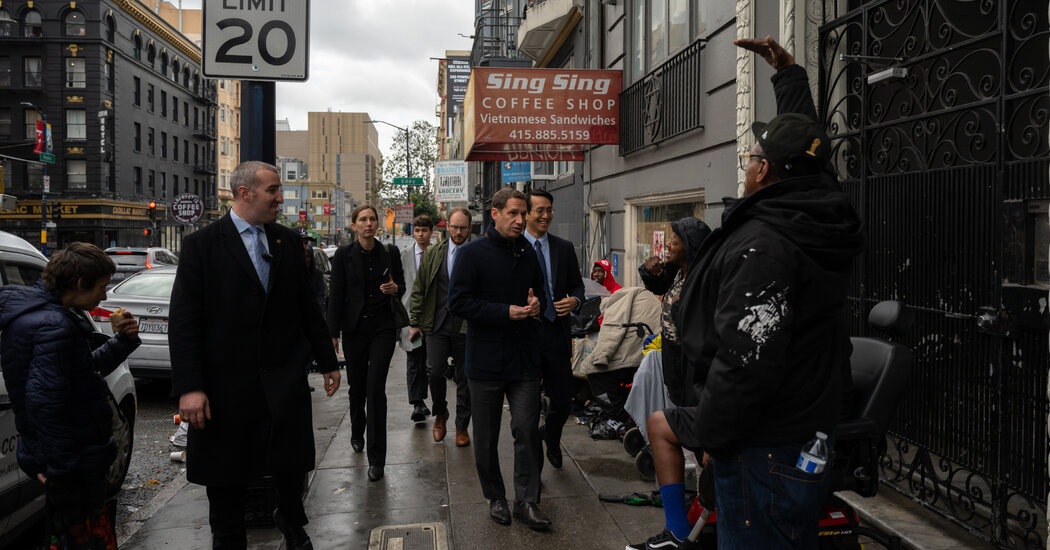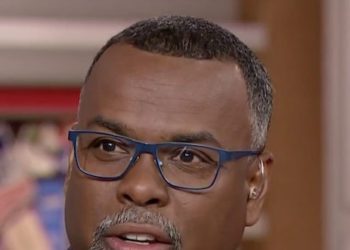Plastic straws are banned in San Francisco, at least if you want to drink a soda or lemonade. Those smoking fentanyl, however, have been able to get them for free, at taxpayers’ expense.
There was also the time five years ago, when the city helped pay for a billboard that showed smiling, glittery partygoers. “Do it with friends,” the public service message said, urging drug users to consume with others so they could treat a potential overdose.
For decades, San Francisco has been a liberal city where those using drugs found easy access to their substance of choice and a government generally willing to tolerate addiction. City leaders emphasized a harm reduction approach, believing that more lives would be saved by helping users to consume safely than by punishing them.
But Daniel Lurie, the moderate Democrat who became the city’s new mayor in January, said this week that things had gone too far. He told The New York Times that he would announce on Wednesday a new policy that walks back the free distribution of clean foil, pipes and plastic straws on the streets of San Francisco. The supplies were typically used to smoke fentanyl or methamphetamines, and the city spent hundreds of thousands of dollars per year on them.
Mr. Lurie’s rollback was the latest sign that San Francisco was moving away from the far-left ideology that had made it a target of late-night comedians and conservative politicians. In recent years, voters have signaled a political shift by ousting a progressive district attorney and electing more moderate city leaders, including the new mayor and Board of Supervisors.
“We’ve lost our way,” Mr. Lurie said on Tuesday as he walked around the city’s Tenderloin neighborhood, where fentanyl use and open-air drug markets have proliferated. “We are no longer going to sit by and allow people to kill themselves on the streets.”
For years, San Francisco has handed out smoking supplies, partly to make connections with users in hopes of getting them into treatment and partly because that form of drug use is believed to be safer than injections.
San Francisco is hardly the only American city that has used the approach to address drug addiction. Other California cities have passed out drug smoking supplies, backed by state funding, as have nonprofits in Seattle, Portland and New York City. In 2021, New York City also became the first in the United States to open official sites for drug users to inject themselves under supervision.
But few cities are considered as permissive as San Francisco. Nonprofits here have brought kits of drug paraphernalia to people on the street, no questions asked.
Mr. Lurie said this week that he would not end the distribution of smoking supplies outright, but that he wanted to put strict conditions on it.
As of April 30, all paraphernalia — including smoking supplies and needles for injection — will only be distributed to those who undergo lengthy counseling sessions that are designed to steer them into treatment or toward other resolutions, like accepting a free bus ticket out of the city.
Nonprofits will only be able to distribute smoking supplies in city-sanctioned buildings and cannot hand them out on the street. Programs that currently set up paraphernalia tables on sidewalks will be ordered to move indoors. Nonprofits can still provide clean needles on the street, however.
Mr. Lurie said he stopped short of banning distribution altogether because he still believes in the importance of the harm reduction approach, which prioritizes keeping drug users alive and as healthy as possible until they are ready to accept treatment.
In November, Mr. Lurie defeated London Breed, the incumbent, on a platform of reducing crime and fentanyl use in the city. He was backed by a number of business leaders, many of whom he has enlisted in efforts to improve San Francisco.
The city was among the hardest hit by the Covid-19 pandemic, which caused its downtown office towers to empty out and its sidewalks to become dotted with tent encampments and drug markets..
As Mr. Lurie walked around the Tenderloin on Tuesday, some people were unconscious, leaning over or openly using drugs as city officials looked on. Mr. Lurie knelt beside a few of them, offering help, but nobody took him up on it.
Mr. Lurie and his public health director, Daniel Tsai, said that it was a priority to get people off drugs, particularly fentanyl, which can be deadly even in tiny amounts. Since 2020, the city’s drug crisis has killed more than 3,000 people — more than Covid-19, homicides and car crashes combined.
Also forgotten by past city leaders, the mayor said, was the importance of safe neighborhoods in which children and seniors do not have to wind their way through drug markets or step over unconscious people as they head to school or run errands.
The goal of putting conditions on the distribution of supplies, Mr. Tsai said, is to move as many people as possible into treatment. The city also plans to send neighborhood-based street teams to reach out to drug users, add more shelter and treatment beds, and require proof of residency in San Francisco to obtain county welfare benefits.
The distribution of naloxone, a medication that can reverse an opioid overdose, will not be affected. Mr. Lurie said that he keeps naloxone in his city-provided Chevrolet Tahoe, and Mr. Tsai said he carries some in his suit jacket. Neither man has personally administered it.
Keith Humphreys, a professor of psychiatry at Stanford University who served as a drug policy adviser in the Obama administration, said San Francisco’s change in paraphernalia distribution is another example of West Coast cities — including Seattle; Portland; and Vancouver, British Columbia — rethinking their near-total reliance on harm reduction and focusing on treatment and law enforcement as well.
“The populace has risen up and said, ‘Enough already,’” he said.
In San Francisco, harm reduction began during the height of the AIDS crisis, when the sharing of contaminated needles by intravenous drug users enabled H.I.V. to spread.
At the time, syringes were only available with a doctor’s prescription. In San Francisco, an experimental program, Prevention Point, sent volunteers posing as parents pushing baby strollers out into the streets. There were no babies inside — only free, clean syringes.
Distributing clean needles proved effective in curbing the spread of H.I.V., and the city soon supported the effort with taxpayer money. Studies have shown that needle exchanges work to reduce the transmission of H.I.V., hepatitis C and skin infections. But there has been much less scientific study on the effectiveness of distributing safer smoking supplies.
Tyler TerMeer, chief executive of the San Francisco AIDS Foundation, said the same theory behind the needle exchange program held for smoking supplies. Making it harder to obtain foil, pipes and straws might push people toward injecting fentanyl instead, which is considered more harmful, he said.
His foundation sets up mobile stations around the city where drug users can obtain smoking supplies, along with socks and information about treatment and housing. Drawing them in with the foil and straws can help build relationships and encourage them to seek long-term help, he said.
Making it harder to obtain supplies, he said, is “a dangerous step.”
“People are more likely to seek help when they’re treated with dignity and respect rather than stigma and shame,” Mr. TerMeer said.
But Cedric Akbar, a former heroin addict who runs a recovery program in the city, said that he has seen nonprofits handing out packs of supplies without ever mentioning treatment options or asking for any information — including the user’s age. He said that he is certain people as young as 16 have received free smoking supplies.
“This is ideology gone crazy,” he said, adding he would like to see Mr. Lurie take even stronger steps to curb drug use.
Several drug users seemed to be unfazed by the mayor’s changes this week. Pipes can be purchased from smoke shops for a few dollars apiece and foil is available at any grocery store. Some speculated that people would share more supplies or shoplift.
Amber Miller, 39, huddled in the doorway of a shuttered cocktail bar on Monday afternoon to escape the rain. She was with a woman, whom she called her “street sister,” who was barely conscious and bent over at the waist, the telltale stance of a person high on fentanyl.
Ms. Miller said she smokes methamphetamine and has obtained free pipes from nonprofits. She said the handouts and lax attitude toward drug use in San Francisco have made it easy to get stuck because there is nobody pushing her to get off drugs and improve her life.
“I feel trapped. This whole city makes you feel trapped,” she said. “You’re stagnant. You’re comfortable.”
The city has gradually turned toward focusing on treatment. Gone are the billboards telling people to use drugs with friends.
In their place: ad campaigns focused on stories of recovery from drug addiction.
Heather Knight is a reporter in San Francisco, leading The Times’s coverage of the Bay Area and Northern California. More about Heather Knight
The post San Francisco Rethinks Its Free Handouts of Drug Paraphernalia appeared first on New York Times.




